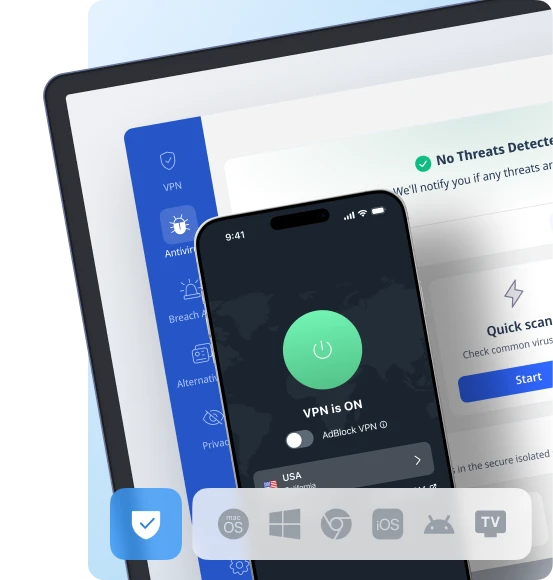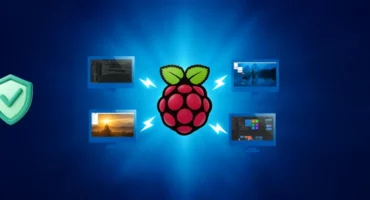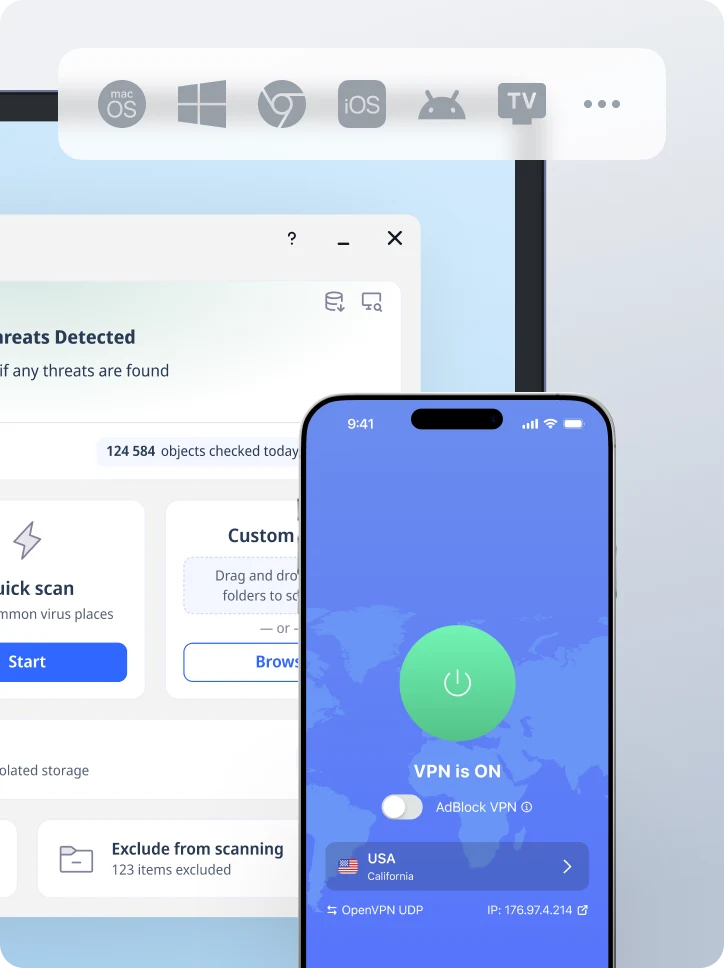Virus vs Malware What Is the Difference and Why Does It Matter?
A virus and malware are terms that are interchangeably used in the cybersecurity world. Nevertheless, malware and virus are different terms in cyber security.
However, they are similar but not identical. Malware and virus are often interchanged, however malware is an umbrella term of malicious software and a virus is a type of malware that can replicate and infect other files. Knowing how malware and a virus are different, and how their meanings differ, is an essential part of making your digital life a safe one – whether it is personal information, playing online, or running a business.

Beef Up Your Cybersecurity with VeePN
Whereas antivirus software tackles known threats such as viruses, and antimalware scans the entire malicious activity, a virtual private network (VPN) such as VeePN provides an active security shield. VeePN secures your Internet connection, conceals your IP address and secures your information against attainment by hideously raising the stakes in terms of malware to communicate with its control server or hackers being able to access unsecured networks. This implies that a VPN may be used to prevent an attack because a VPN would be harder to intercept by an attacker and also cyberattacks on your system.
Having such features as AES-256 encryption, a Kill Switch, and malware blocking, VeePN protects you against new threats before they even reach your device. In case you are using a public WiFi or peer-to-peer file sharing, or visiting a new site, VeePN serves as your cyber night watch.
Malware Explained
Malware refers to malicious software, and acts as a description used to refer to any software that is created to damage, exploit, or otherwise affect the device, network, or user in one way or another. It contains: and may be very varied in form, according to the way they attack and the plan they have in view:
- Viruses
- Worms
- Trojans
- Ransomware
- Spyware
- Adware
- Rootkits
- Keyloggers
- Fileless malware
In the example, there is malware that is in a position to take photos of a device through its camera and then transfers the data.
Such programs may include annoying pests, up to advanced attacks that may lock up your files and demand ransom or gain access to sensitive fiscal data. Ransomware and other malware are commonly introduced into a system using exploit kits.
Being aware of the various types of malware can enable the user to protect their computers, data and networks against infection and damage and defence mechanisms must be designed against viruses as well as other malwares.
Categories of Malware
Malware is a broad term that encompasses a lot of malicious software with the aim of entering, destroying or taking advantage of computer systems. Some of the most widely known malware are viruses, worms, trojans, spyware, adware, and ransomware. All malware are different with different modes of attack and execution.
Viruses are a particular group of malware that replicate themselves by adding their codes in other programs or files. They need the action of the user, e.g. opening an infected file to run and infect.
The other malware that may self replicate and spread autonomously across the networks without the need of a host file or human interaction is worms. This poses a great threat to huge systems and networks.
Trojan horses (also known as Trojans) are malicious programs concealed as genuine software, and fool the user into downloading them. When they are inside, they are capable of gathering sensitive information such as credit cards and passwords, or allow other malware to get in.
The purpose of the spyware is to monitor the activity of the user without informing the user about the fact of monitoring and gathering information that often includes sensitive data like log in or browsing information.
Adware displays advertisements the user does not want to see and may slow down the functioning of the system, and it can also be used to monitor the user to provide them with marketing.
Ransomware takes files or locks them out of their systems, and payment is required to regain access to valuable data.
It is important to understand the variance among these classes of malware in order to come up with efficient protection measures. The better understanding of how each form of malicious software functions, the more the users are able to protect their computers, data and networks concerning infection and damage.
What is a Virus?
Computer virus is a particular kind of malware which expands by copying its code into other programs or files. When this infected file is run, the virus can be released and can destroy system files, erase data or crash your whole system. When a user opens an infected file or application, a virus is launched and its malicious actions are executed.
Speaking about malware and a virus, it is necessary to say that a virus is a certain form of malware having its own behavioral characteristics, including self-replication and the necessity of a user interaction in order to be executed. A virus easily transfers between computer to computer but normally requires a user to transfer or open an infected file but a worm can transfer between two or more computers without any human interaction.
The Spreading of Viruses
Viruses are a very subtle way of malicious software due to their capacity to reproduce and transmit themselves via numerous avenues with varying degrees of control. Infected websites in your computer are one of the most common methods of transmission of the virus, a single visit to an infected site or even the download of a malicious file can lead to the infection of your computer. Another common source is email attachments- the virus may easily spread to other files and programs in the system when a victim opens an infected file.
Viruses are also common in removable media like flash disks. The virus can be introduced by plugging an infected drive into a computer and the once introduced will self replicate itself in the hope of spreading to other computers or mobile devices in the same network. Viruses also have the capability of taking advantage of the flaws that exist in old software or operating systems, which makes them easily able to infect the systems without the user being aware.
A virus can also do a lot of damage once within a system e.g. corrupt data, disrupt system functions or even travel to other computers within a network. To defend against such threats, an updated version of the software and operating systems should be maintained, reputable antivirus programs should be installed, and safe browsing behavior should be applied to prevent the download of malicious software that may come out of unreputable sources.
The Trojan Horse: an Infamous Type of Malware
One of the most notorious kinds of malware are the Trojan horses that are the most cunning and dangerous. As compared to viruses and worms, a Trojan horse does not replicate itself, but it depends on deceiving the users into installing it, by pretending to be an innocent or useful program. The Trojan can infect the system without the user noticing it once he or she downloads and runs the infected application.
Once it gets the access, a Trojan horse is able to leave a backdoor to hackers, through which the hackers can steal sensitive information like passwords, credit card numbers and other sensitive information that the computer has. Further weakening a compromised system, Trojans can be used to install other kinds of malware, such as spyware, adware and ransomware. These malware may gather data, track the activity of the user, or even encrypt data in order to obtain the ransom.
You need to be keen on keeping your computer systems off Trojan horses. Be careful when downloading software, particularly off unknown websites, and use well-known antivirus packages to scan and delete malicious code. It is also important to ensure that your operating system and every program you use is up to date with the latest security patches as Trojans often use vulnerabilities to sneak in. With the help of vigilance and proactive behavior, users will be able to decrease the likelihood of becoming victims of this dangerous form of malware significantly.
The Major Differences between Malware and a Virus
What You Can Do
👍Install a premium VPN such as VeePN: Protect your network against man in the middle and data interception.
👍Install virus and malware protections: Protect against viruses as well as other malicious programs.
👍Keep your software current: Updates seal holes in security.
👍Avoid suspicious downloads: Never download unless you are sure about it.
👍Strong passwords and MFA: Add the extra security to your accounts.
Final Thoughts
Although all viruses are malware, not all malware is viruses. Being aware of this difference will make you more informed and more secure. And in the digital world today that is half the battle won. Avoiding scams and getting rid of the stress of browsing the Web is only a matter of smart behavior and a strong tool, such as VeePN.
VeePN is freedom
Download VeePN Client for All Platforms
Enjoy a smooth VPN experience anywhere, anytime. No matter the device you have — phone or laptop, tablet or router — VeePN’s next-gen data protection and ultra-fast speeds will cover all of them.
Download for PC Download for Mac IOS and Android App
IOS and Android App
Want secure browsing while reading this?
See the difference for yourself - Try VeePN PRO for 3-days for $1, no risk, no pressure.
Start My $1 TrialThen VeePN PRO 1-year plan






